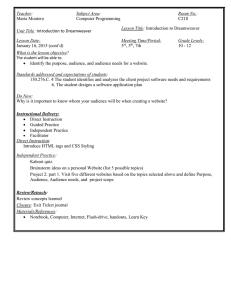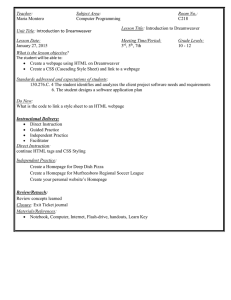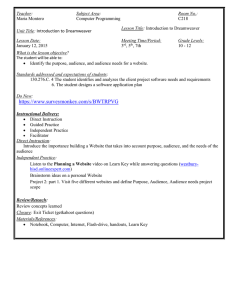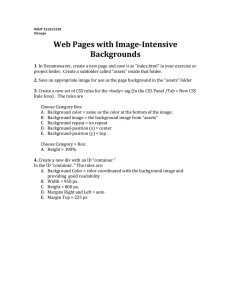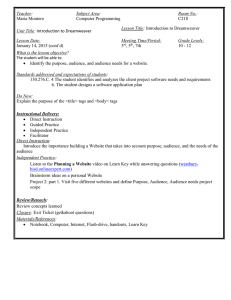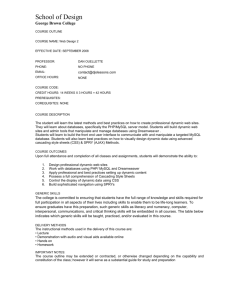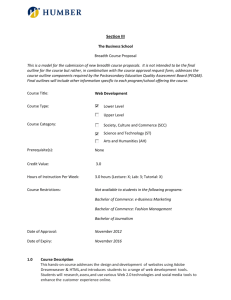Introduction to Web Design — Course Syllabus Website Design
advertisement
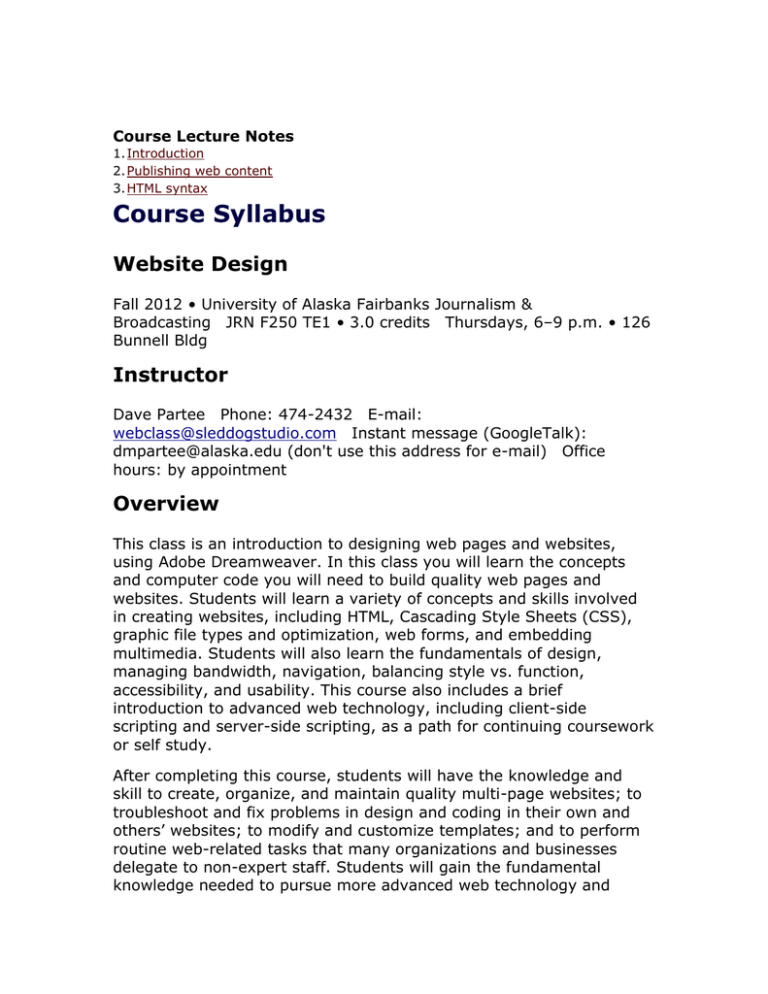
Introduction to Web Design — Course Lecture Notes 1. Introduction 2. Publishing web content 3. HTML syntax Course Syllabus Website Design Fall 2012 • University of Alaska Fairbanks Journalism & Broadcasting JRN F250 TE1 • 3.0 credits Thursdays, 6–9 p.m. • 126 Bunnell Bldg Instructor Dave Partee Phone: 474-2432 E-mail: webclass@sleddogstudio.com Instant message (GoogleTalk): dmpartee@alaska.edu (don't use this address for e-mail) Office hours: by appointment Overview This class is an introduction to designing web pages and websites, using Adobe Dreamweaver. In this class you will learn the concepts and computer code you will need to build quality web pages and websites. Students will learn a variety of concepts and skills involved in creating websites, including HTML, Cascading Style Sheets (CSS), graphic file types and optimization, web forms, and embedding multimedia. Students will also learn the fundamentals of design, managing bandwidth, navigation, balancing style vs. function, accessibility, and usability. This course also includes a brief introduction to advanced web technology, including client-side scripting and server-side scripting, as a path for continuing coursework or self study. After completing this course, students will have the knowledge and skill to create, organize, and maintain quality multi-page websites; to troubleshoot and fix problems in design and coding in their own and others’ websites; to modify and customize templates; and to perform routine web-related tasks that many organizations and businesses delegate to non-expert staff. Students will gain the fundamental knowledge needed to pursue more advanced web technology and development, either through structured or self-directed learning. Weekly classes will begin with a lecture presenting new material, which may include students performing directed tasks on their computers. The lecture will normally be followed by assigned exercises to practice the new skills and put concepts into practice, with time at the end for students to work on homework assignments, ask questions, or get one-on-one help. Exams and quizzes will test students’ understanding of concepts presented during lectures, and knowledge of HTML and CSS syntax. Assignments and a final project will allow students to demonstrate practical ability in designing and coding websites. Computers and Software The class is held in a lab with Macintosh computers. Students may be able to use their own laptops (Mac or PC) in the classroom, if they have Dreamweaver installed, although they may need to occasionally access files and take exams using the lab computers. The university does not provide copies of Dreamweaver that can be installed on students' personal computers. Students can use labs on campus that have Dreamweaver installed to complete assignments, including the classroom (when not in use by another class). Students can purchase their own copies of Dreamweaver or the Adobe Creative Suite, although the software is fairly expensive even with the education discount. Adobe makes available a 30-day free trial of Dreamweaver through their website, but this will only cover a fraction of the semester timeframe. Adobe also has a new monthly software rental program, but they do not have an educational discount currently. Required and Recommended Textbooks This class meets only once a week but still needs to cover a full semester of material, and so there is a lot of new material presented in a single class—more than most can absorb from a lecture alone. It is therefore particularly important that you prepare for class by studying the assigned readings in advance, gaining some familiarity and comfort with the week's topics before coming to class. Required Sams Teach Yourself HTML and CSS in 24 Hours, Eighth Edition. Julie Meloni, Michael Morrison, Sams Publishing, 2010. Dreamweaver CS6 for Windows and Macintosh (Visual QuickStart Guide). Tom Nigrino, Dori Smith, Peachpit Press, 2012. Other readings as assigned, available via web or by handout. Evaluation and Grades Students will receive a numerical score on each assignment and test. Final letter grades are determined by scores (as a percentage of total possible points) in the following weighted areas: 10 % 15 Midterm % Assignme 35 nts % Final 20 project % Final 20 exam % Final letter grades are assigned using the percentage scale: A+ (100– 97), A (96–93), A- (92–90), B+ (89–87), B (86–83), B- (82–80), C+ (79–77), C (76–73), C- (72–70), D+ (69–67), D (66–63), D- (62–60), F (59–0). Quizzes Assignments should be turned in on time. There will be a 20% deduction for assignments submitted after the due date. Prerequisites There are no required course prerequisites. However, students should have familiarity with the World Wide Web, Internet browsers, and the Macintosh or Windows operating system. For those without these skills, it is recommended that you first take CIOS F146 (Using Internet Tools and Technology) or similar. Blackboard This class will use the web-based Blackboard system for assignments, quizzes and parts of exams. Every student needs to have access to the course via Blackboard. Students can also monitor their assignments and grades via Blackboard. For help accessing or using Blackboard, look for the "Blackboard Resources" area of the Blackboard home page. Attendance Attendance and participation in class is important. If you have a planned absence, let me know in advance. If you have an emergency absence, let me know as soon as you are able. Computer Support I will provide computer support during class, and provide help outside of class on software problems related to the course and course material, including Dreamweaver and Photoshop. For general computer support outside of class (hardware or operating system troubleshooting and support for your personal computer, or in a University lab), students should contact the UAF Help Desk at helpdesk@alaska.edu or 450-8300, or the support personnel for the lab. E-mail will be a primary mode of communication outside of class during the semester. You need to regularly check your university @alaska.edu e-mail account, or set it to forward to your preferred email account. To contact me, use my dedicated class account (webclass@sleddogstudio.com), instead of my university account. Data Loss Students are responsible for making sure their computer work is safeguarded. That means keeping a backup of files on CD, ZIP, Flash drives, etc. Students should not assume that their data will be saved from week to week on classroom computers. A USB flash drive (a.k.a. "jump drive" or "thumb drive") is highly recommended for use during the course (anything greater than 512MB is sufficient), and can be purchased for as little as $15. You can get these at the UAF bookstore, most department stores, or online (e.g., Amazon). Withdrawal and Drops The last day for student-initiated drop (course does not appear on academic record) is Friday, September 14. The deadline for studentinitiated withdrawal (W grade appears on transcript) is Friday, October 26. Additional Fees This course does not have a separate lab fee. You will need to register your own web domain name, which should cost no more than $15. Disabilities Services The Office of Disability Services implements the Americans with Disabilities Act (ADA) and ensures that UAF students have equal access to the campus and course materials. I will work with the Office of Disabilities Services to provide reasonable accommodation to students with disabilities. Schedule (subject to change) The reading listed for each week should be completed prior to that week's class, not after. Week 1 Aug 30 • Course introduction • How the web works • Introduction to (X)HTML syntax Week 2 Sep 6 • Creating and publishing web content reading • HTML and CSS: Chapter 1, 2 • Dreamweaver.: Chapter 1, 2, 3 Week 3 Sep 13 • HTML syntax • Validating code reading • HTML and CSS: Chapter 3 • Dreamweaver: Chapter 4, 17 Week 4 Sep 20 • Basics of CSS reading • HTML and CSS: Chapter 4 • Dreamweaver: Chapter 7, 9 Quiz #1 Week 5 Sep 27 • Formatting text • Lists reading • HTML and CSS: Chapter 5, 6 • Dreamweaver: Chapter 18 (site management) Week 6 Oct 4 • Tables • Links • Colors reading • HTML and CSS: Chapter 7, 8, 9 • Dreamweaver: Chapter 6, 10 Quiz #2 Week 7 Oct 11 • Images reading • HTML and CSS: Chapter 10, 11 • Dreamweaver: Chapter 5, through p. 157 Week 8 Oct 18 • Images, continued Midterm Exam Week 9 Oct 25 • Embedding multimedia reading • HTML and CSS: Chapter 12 • Dreamweaver: Chapter 5, pp. 158-164 Week 10 Nov 1 • Advanced CSS reading • HTML and CSS: Chapter 14, 15 • Dreamweaver: Chapter 8 Quiz #3 Week 11 Nov 8 • List formatting basics • Formatting lists as navigation reading • HTML and CSS: Chapter 16, 17 • Dreamweaver: Chapter 16 (Library items, templates) Week 12 Nov 15 • Forms reading • HTML and CSS: Chapter 22 • Dreamweaver: Chapter 11 Quiz #4 Week 13 Nov 29 • Advanced CSS techniques reading • HTML and CSS: Chapter 18 • Dreamweaver: Chapter 13 Week 14 Dec 6 • Intro to server-side web programming • Intro to client-side web programming reading • HTML and CSS: Chapter 21 Final Project due Dec 10 (Monday) 11:59 PM Final Exam Dec 13 (Thursday) 8:00 – 10:00 PM • All material from the course /webdesign/syllabus/syllabus-jrn250f12.php was last modified 3 September 2012. For comments or questions, contact Dave Partee. Validation: XHTML 1.0 • CSS v3 • WCAG 2.0/AA
